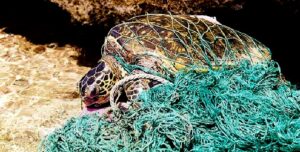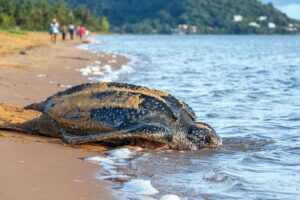Leatherback turtles, the ancient mariners of our oceans, face a perilous plight that threatens their existence. The question of why are leatherback turtles endangered encompasses a myriad of challenges, from human activities to environmental changes.
Understanding the factors contributing to their vulnerability unveils a complex narrative intertwined with habitat loss, climate shifts, fishing practices, and pollution. Delving into the depths of this issue reveals the urgent need for concerted efforts to safeguard these gentle giants and preserve the delicate balance of our marine ecosystems.
Are leatherback turtles endangered?

Yes, leatherback turtles are sadly endangered. They have been listed as such under the Endangered Species Act since 1970, and their populations have seen a concerning decline of 40% over the past three generations.
Leatherback turtles face various threats, including habitat loss, climate change, pollution, and incidental capture in fisheries. Conservation efforts are crucial to protecting their nesting sites and addressing these threats to ensure the survival of the species.
For the most current information on the status of leatherback turtles, I recommend checking the latest updates from reputable sources such as the IUCN or other conservation organizations. Conservation statuses can be subject to change based on ongoing research and monitoring efforts.
Why are leatherback sea turtles endangered? 20 Reasons
Leatherback sea turtles (Dermochelys coriacea) face numerous threats that contribute to their endangered status. While it might be challenging to list exactly 20 reasons, here are some key factors that contribute to the decline of leatherback sea turtle populations:
- Habitat Loss: Coastal development, pollution, and human activities can destroy nesting habitats and affect the availability of suitable nesting sites.
- Climate Change: Rising temperatures and changes in sea level can impact the distribution and quality of nesting sites. Additionally, climate change can influence the sex ratio of hatchlings.
- Light Pollution: Artificial lights on beaches can disorient hatchlings, leading them away from the ocean and reducing their chances of survival.
- Egg Collection: Illegal collection of leatherback turtle eggs for consumption or trade is a significant threat, particularly in some regions where the eggs are considered a delicacy.
- Poaching: Leatherback turtles are sometimes hunted for their meat, skin, and shells, despite legal protections.
- Incidental Capture: Leatherbacks can get accidentally caught in fishing gear such as trawl nets, longlines, and gillnets. This bycatch is a significant threat to their populations.
- Plastic Pollution: Ingestion of plastic debris, including plastic bags and other marine litter, can be fatal to leatherback turtles.
- Chemical Pollution: Pollution from agricultural runoff, oil spills, and other sources can contaminate the waters and affect the health of leatherback turtles.
- Ocean Pollution: Debris and pollutants in the ocean, including oil and chemicals, can harm leatherbacks directly or indirectly through the contamination of prey.
- Changes in Prey Availability: Overfishing and changes in the distribution of jellyfish (a primary prey for leatherbacks) can impact the availability of their food source.
- Disease: Leatherbacks are susceptible to various diseases, including fibropapillomatosis, which can be linked to pollution and compromised immune systems.
- Global Fisheries: Large-scale industrial fishing operations can have detrimental effects on leatherback populations, leading to increased mortality through bycatch.
- Predation: Increased predation on nests by animals such as raccoons, dogs, and other mammals can significantly reduce hatchling success rates.
- Noise Pollution: Anthropogenic noise from shipping, construction, and other human activities can disrupt the communication and navigation of leatherback turtles.
- Temperature-Dependent Sex Determination: The sex of leatherback turtle hatchlings is determined by the temperature of the nesting environment. Climate change-induced temperature variations can skew sex ratios and affect population dynamics.
- Loss of Seagrass Beds: Seagrass beds, important foraging habitats for leatherbacks, are being lost due to coastal development, pollution, and climate change.
- Invasive Species: Introduced species, such as rats and mongooses, can prey on eggs and hatchlings, further reducing survival rates.
- Tourism Impact: Unregulated tourism on nesting beaches can disturb nesting females and their nests, leading to lower reproductive success.
- Limited Genetic Diversity: Leatherback turtle populations may suffer from reduced genetic diversity, making them more susceptible to diseases and environmental changes.
- Inadequate Conservation Measures: Insufficient protection, enforcement, and management of nesting sites and marine environments contribute to the continued decline of leatherback sea turtles.
It’s essential to address these threats through conservation efforts, legislation, and public awareness to ensure the survival of leatherback sea turtles.


